Patents Directory for Dr. Gary K. Michelson — U.S. Published Patents only
340 patents found - Page 3
| Patent | Abstract |
|---|---|
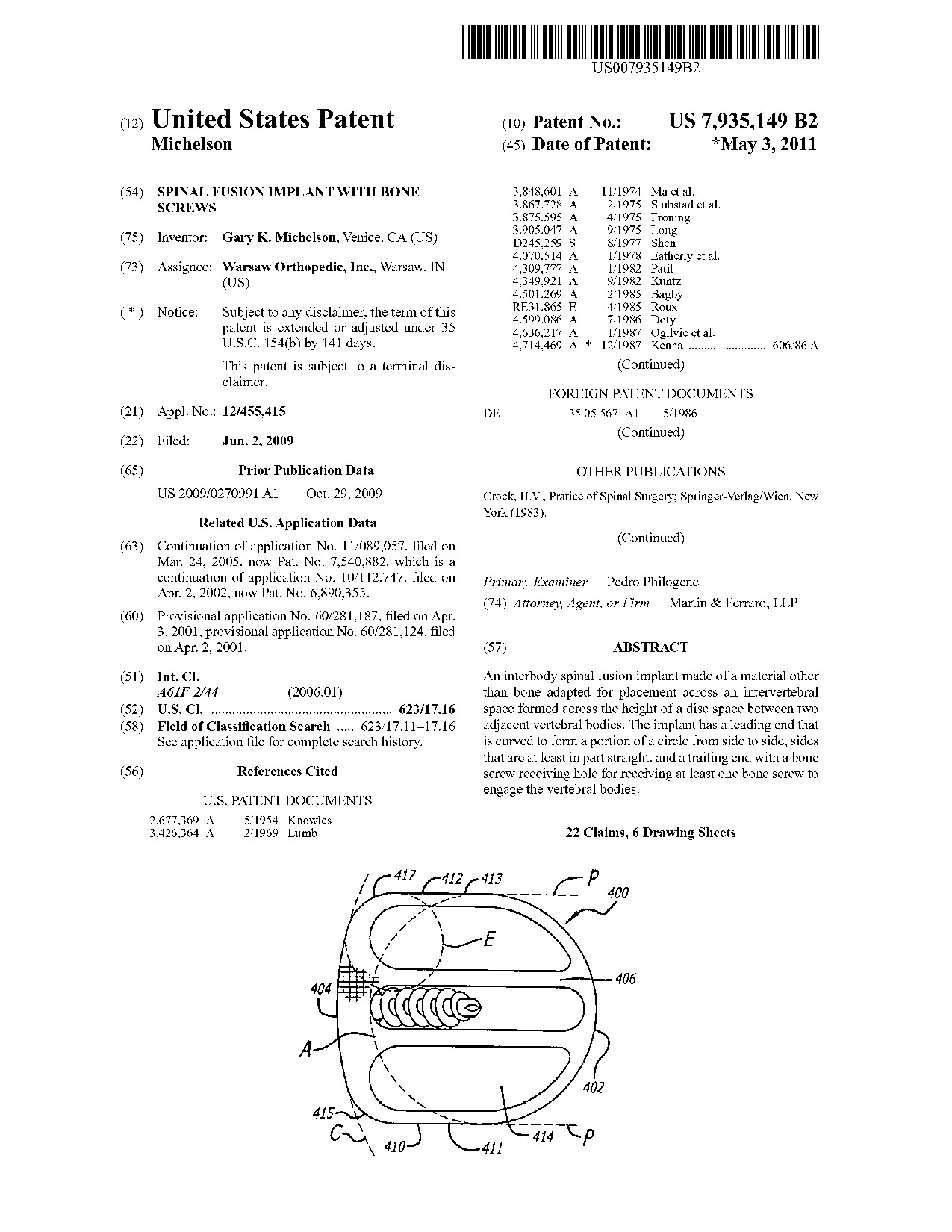 Spinal fusion implant with bone screws - Patent 7,935,149 Spinal fusion implant with bone screws - Patent 7,935,149
|
An interbody spinal fusion implant made of a material other than bone adapted for placement across an intervertebral space formed across the height of a disc space between two adjacent vertebral bodies. The implant has a leading end that is curved to form a portion of a circle from side to side, sides that are at least in part straight, and a trailing end with a bone screw receiving hole for receiving at least one bone screw to engage the vertebral bodies.
|
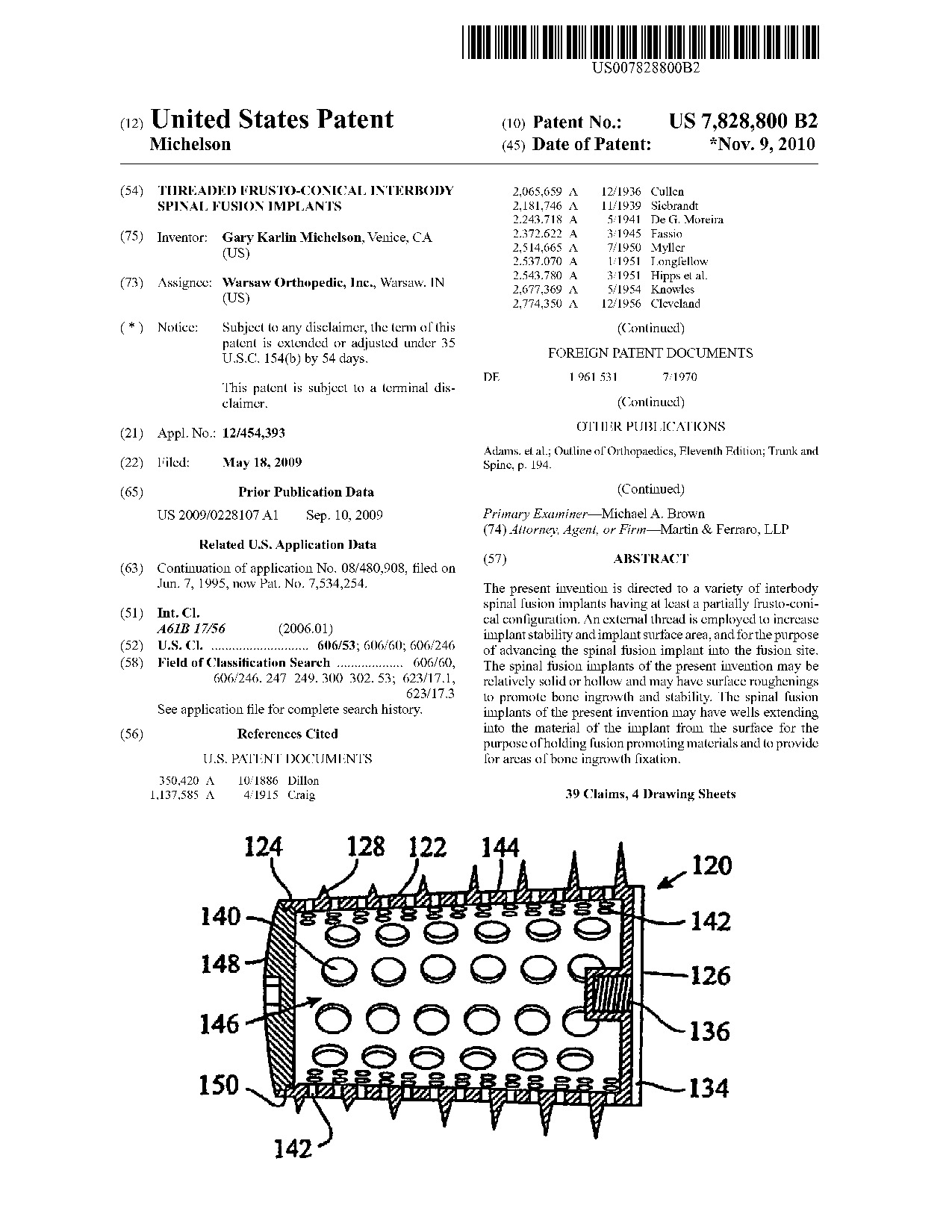 Threaded frusto-conical interbody spinal fusion implants - Patent 7,828,800 Threaded frusto-conical interbody spinal fusion implants - Patent 7,828,800
|
The present invention is directed to a variety of interbody spinal fusion implants having at least a partially frusto-conical configuration. An external thread is employed to increase implant stability and implant surface area, and for the purpose of advancing the spinal fusion implant into the fusion site. The spinal fusion implants of the present invention may be relatively solid or hollow and may have surface roughenings to promote bone ingrowth and stability. The spinal fusion implants of the present invention may have wells extending into the material of the implant from the surface for the purpose of holding fusion promoting materials and to provide for areas of bone ingrowth fixation.
|
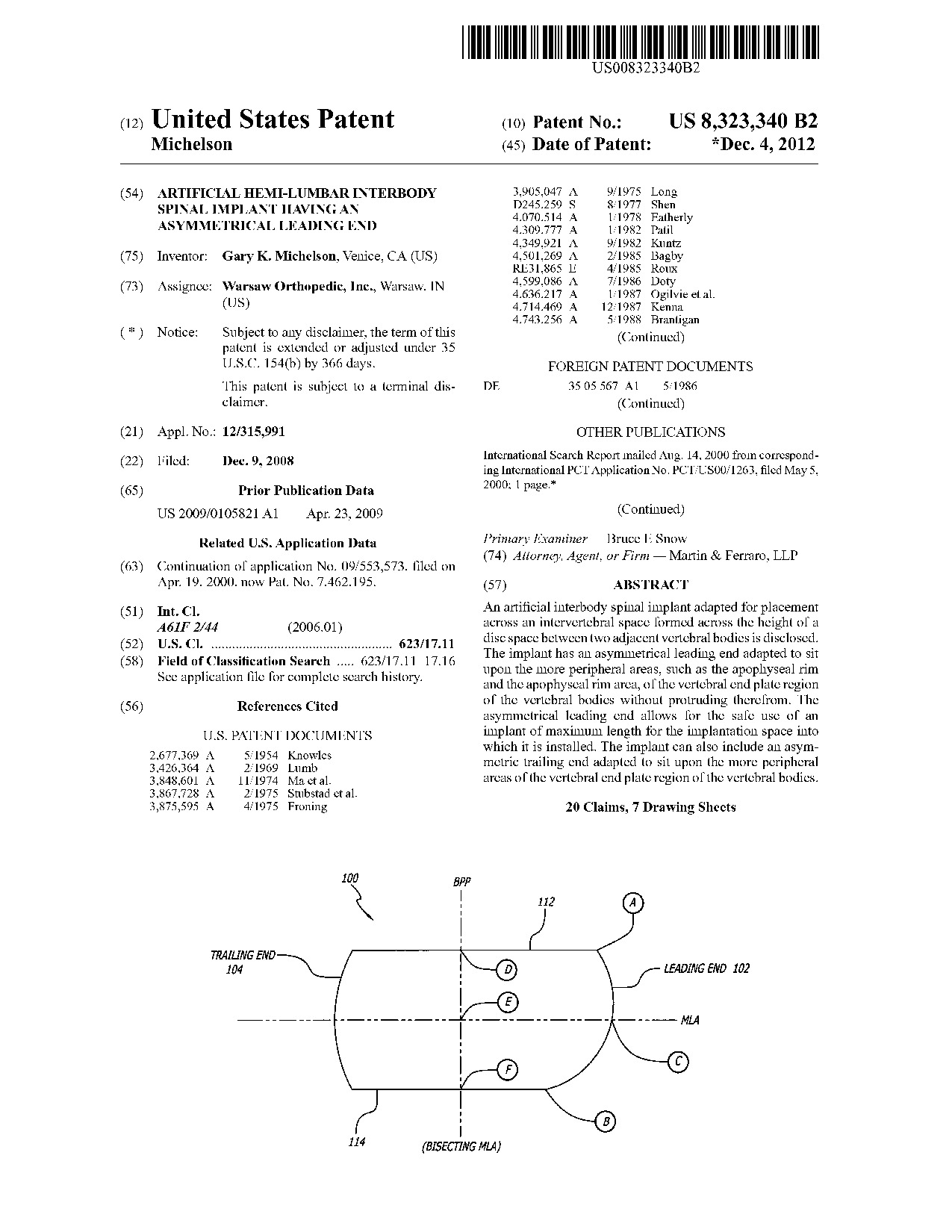 Artificial hemi-lumbar interbody spinal implant having an asymmetrical leading end - Patent 8,323,340 Artificial hemi-lumbar interbody spinal implant having an asymmetrical leading end - Patent 8,323,340
|
An artificial interbody spinal implant adapted for placement across an intervertebral space formed across the height of a disc space between two adjacent vertebral bodies is disclosed. The implant has an asymmetrical leading end adapted to sit upon the more peripheral areas, such as the apophyseal rim and the apophyseal rim area, of the vertebral end plate region of the vertebral bodies without protruding therefrom. The asymmetrical leading end allows for the safe use of an implant of maximum length for the implantation space into which it is installed. The implant can also include an asymmetric trailing end adapted to sit upon the more peripheral areas of the vertebral end plate region of the vertebral bodies.
|
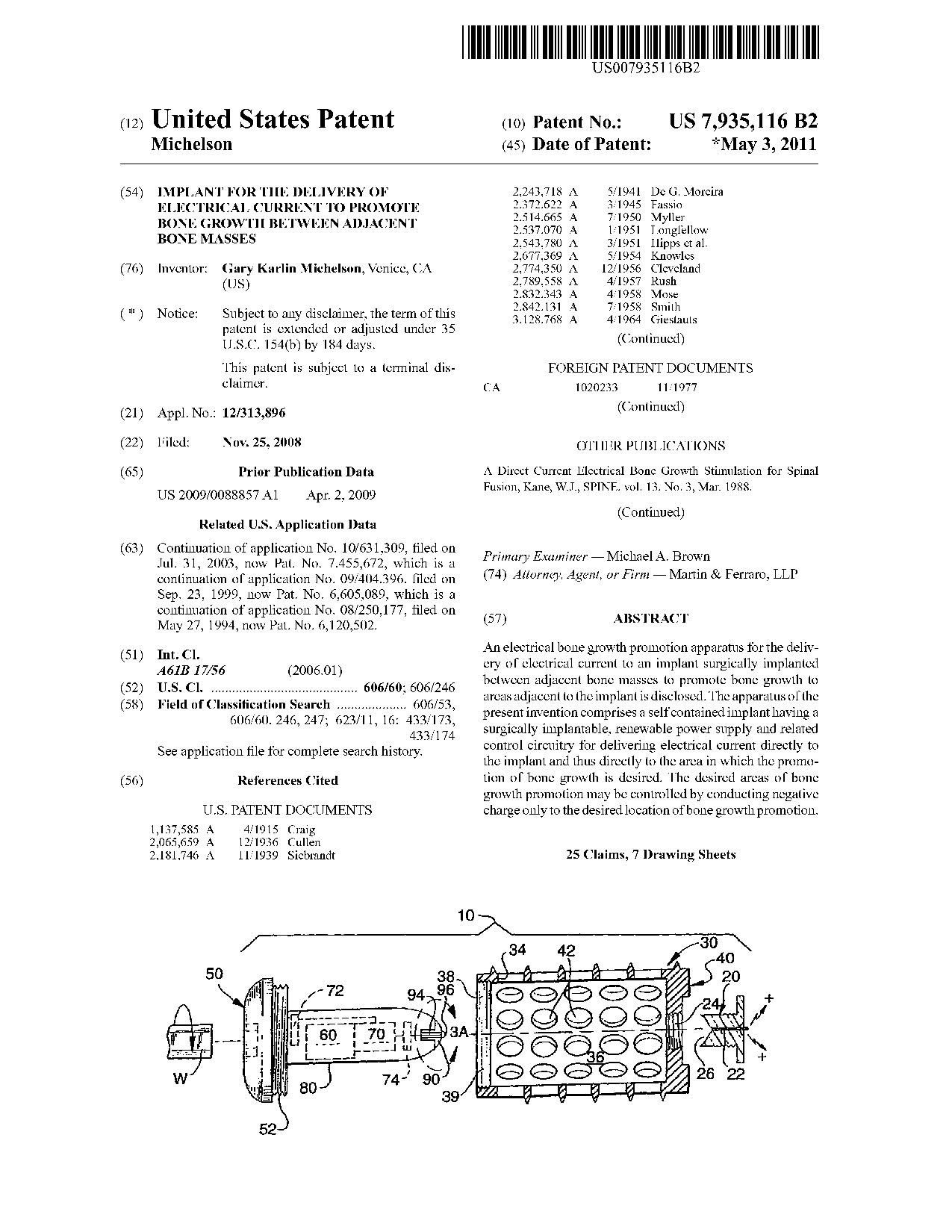 Implant for the delivery of electrical current to promote bone growth between adjacent bone masses - Patent 7,935,116 Implant for the delivery of electrical current to promote bone growth between adjacent bone masses - Patent 7,935,116
|
An electrical bone growth promotion apparatus for the delivery of electrical current to an implant surgically implanted between adjacent bone masses to promote bone growth to areas adjacent to the implant is disclosed. The apparatus of the present invention comprises a self contained implant having a surgically implantable, renewable power supply and related control circuitry for delivering electrical current directly to the implant and thus directly to the area in which the promotion of bone growth is desired. The desired areas of bone growth promotion may be controlled by conducting negative charge only to the desired location of bone growth promotion.
|
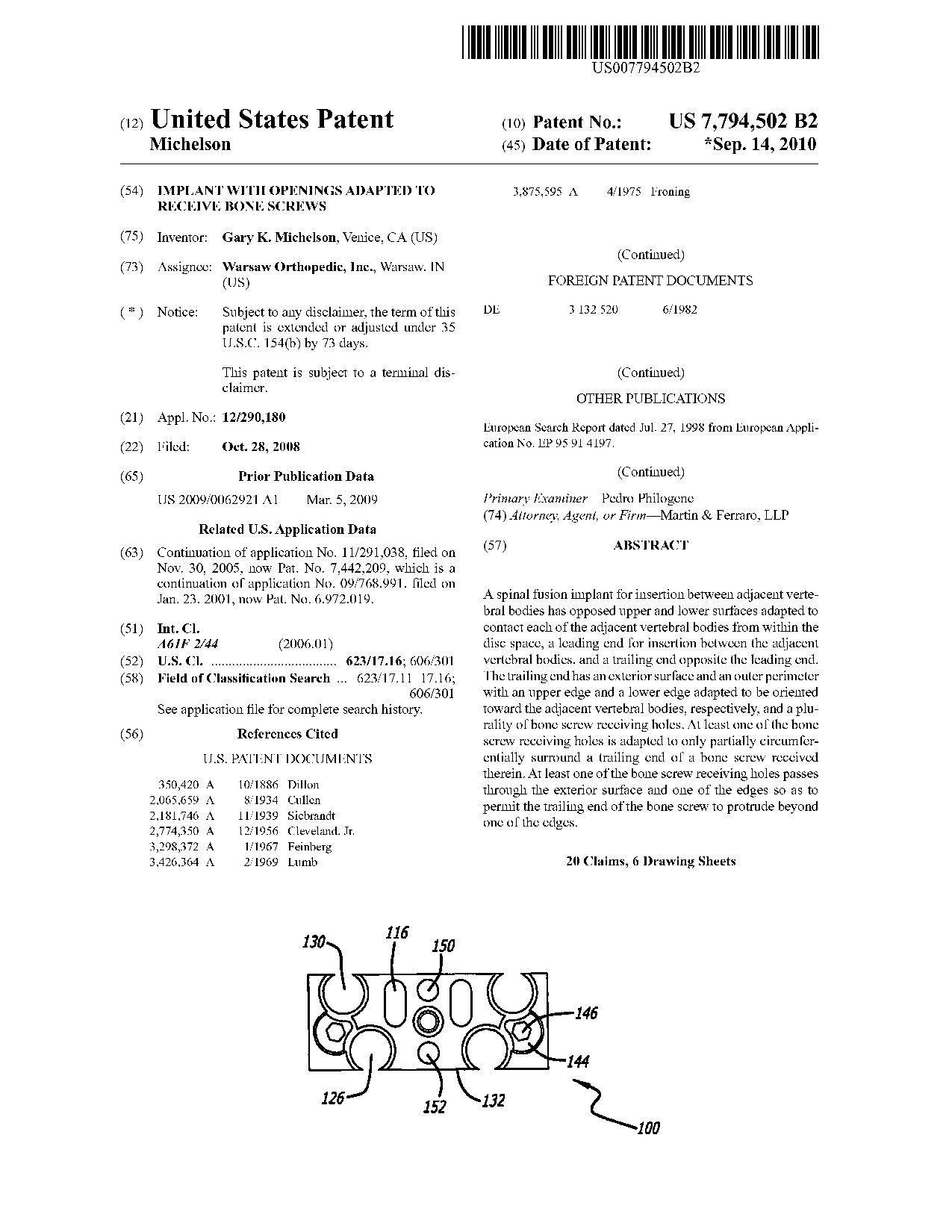 Implant with openings adapted to receive bone screws - Patent 7,794,502 Implant with openings adapted to receive bone screws - Patent 7,794,502
|
A spinal fusion implant for insertion between adjacent vertebral bodies has opposed upper and lower surfaces adapted to contact each of the adjacent vertebral bodies from within the disc space, a leading end for insertion between the adjacent vertebral bodies, and a trailing end opposite the leading end. The trailing end has an exterior surface and an outer perimeter with an upper edge and a lower edge adapted to be oriented toward the adjacent vertebral bodies, respectively, and a plurality of bone screw receiving holes. At least one of the bone screw receiving holes is adapted to only partially circumferentially surround a trailing end of a bone screw received therein. At least one of the bone screw receiving holes passes through the exterior surface and one of the edges so as to permit the trailing end of the bone screw to protrude beyond one of the edges.
|
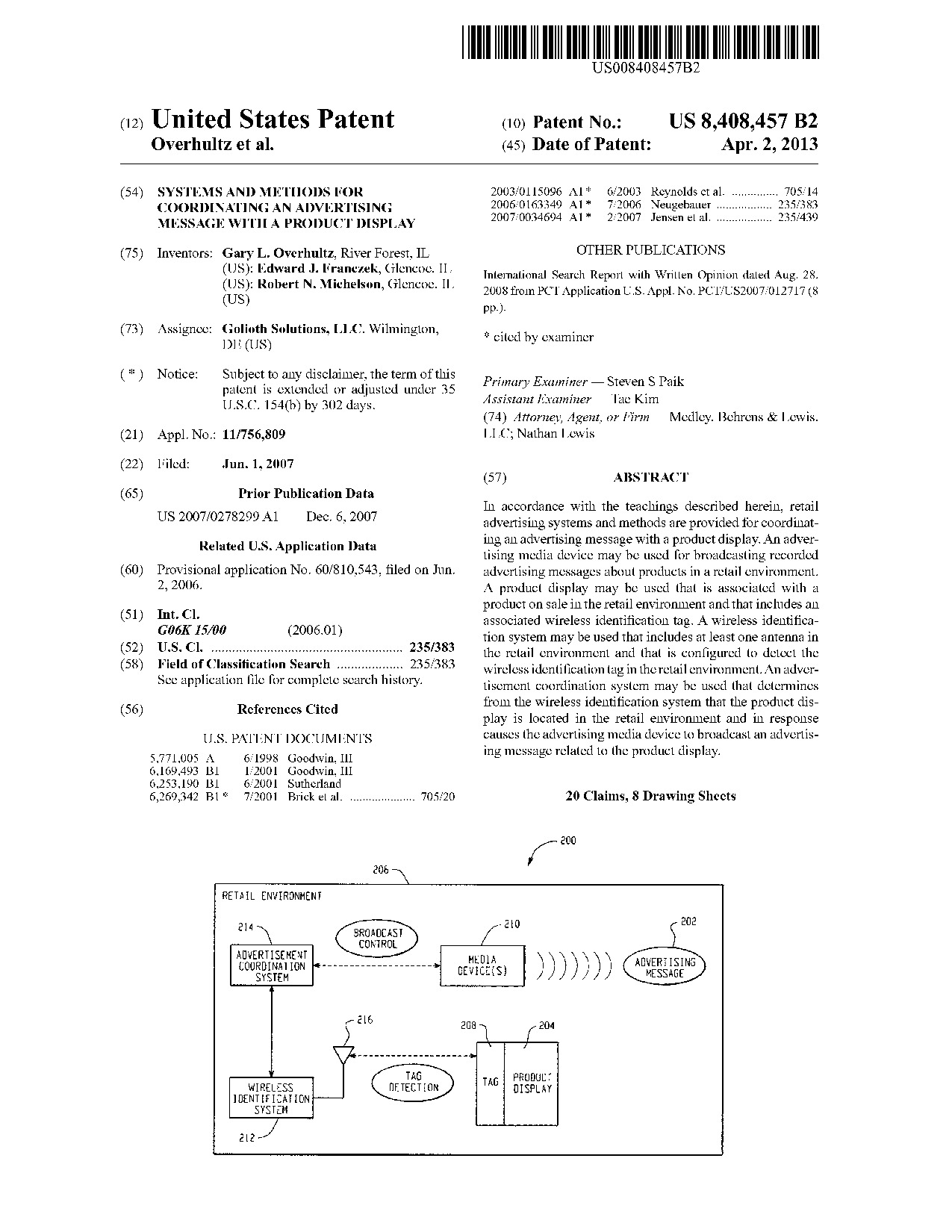 Systems and methods for coordinating an advertising message with a product display - Patent 8,408,457 Systems and methods for coordinating an advertising message with a product display - Patent 8,408,457
|
In accordance with the teachings described herein, retail advertising systems and methods are provided for coordinating an advertising message with a product display. An advertising media device may be used for broadcasting recorded advertising messages about products in a retail environment. A product display may be used that is associated with a product on sale in the retail environment and that includes an associated wireless identification tag. A wireless identification system may be used that includes at least one antenna in the retail environment and that is configured to detect the wireless identification tag in the retail environment. An advertisement coordination system may be used that determines from the wireless identification system that the product display is located in the retail environment and in response causes the advertising media device to broadcast an advertising message related to the product display.
|
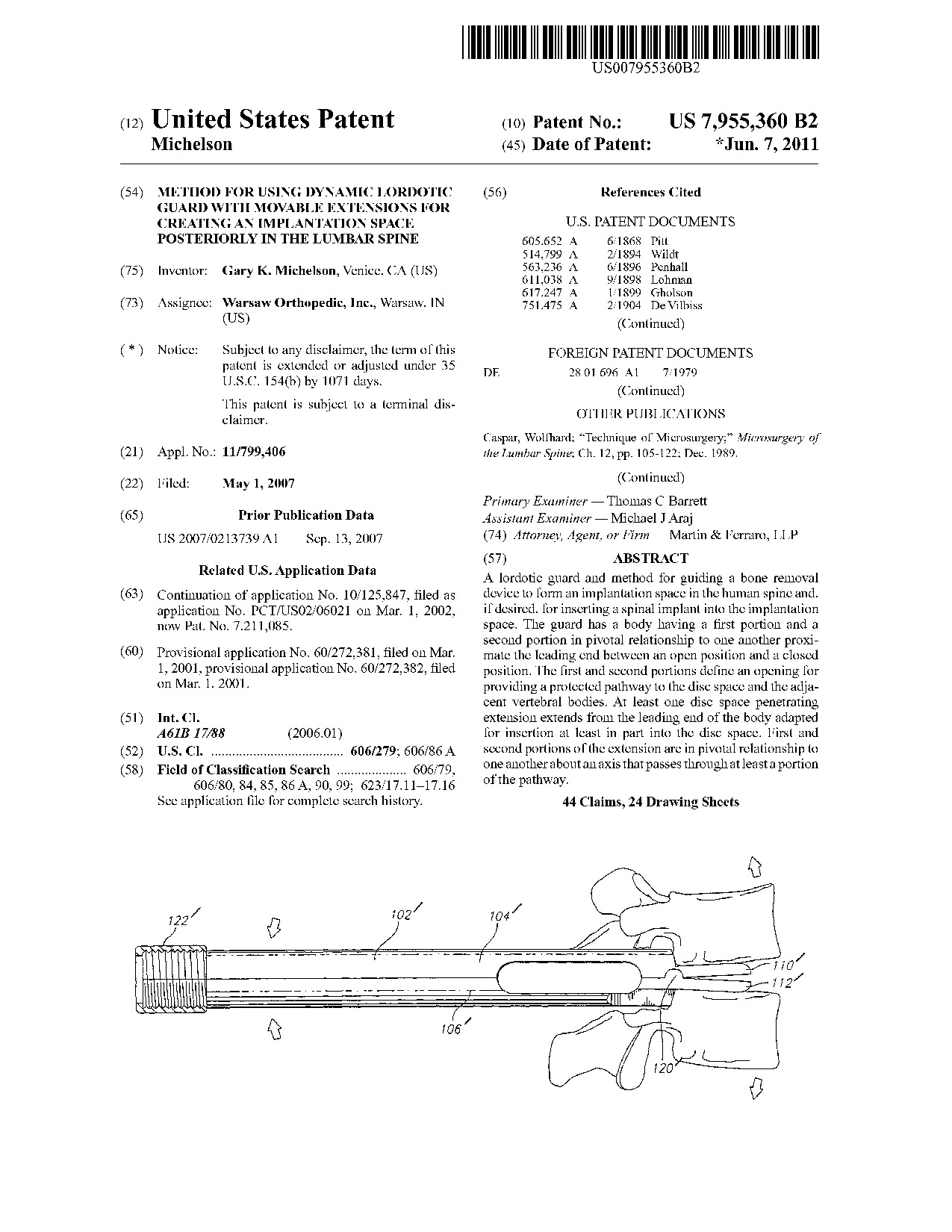 Method for using dynamic lordotic guard with movable extensions for creating an implantation space posteriorly in the lumbar spine - Patent 7,955,360 Method for using dynamic lordotic guard with movable extensions for creating an implantation space posteriorly in the lumbar spine - Patent 7,955,360
|
A lordotic guard and method for guiding a bone removal device to form an implantation space in the human spine and, if desired, for inserting a spinal implant into the implantation space. The guard has a body having a first portion and a second portion in pivotal relationship to one another proximate the leading end between an open position and a closed position. The first and second portions define an opening for providing a protected pathway to the disc space and the adjacent vertebral bodies. At least one disc space penetrating extension extends from the leading end of the body adapted for insertion at least in part into the disc space. First and second portions of the extension are in pivotal relationship to one another about an axis that passes through at least a portion of the pathway.
|
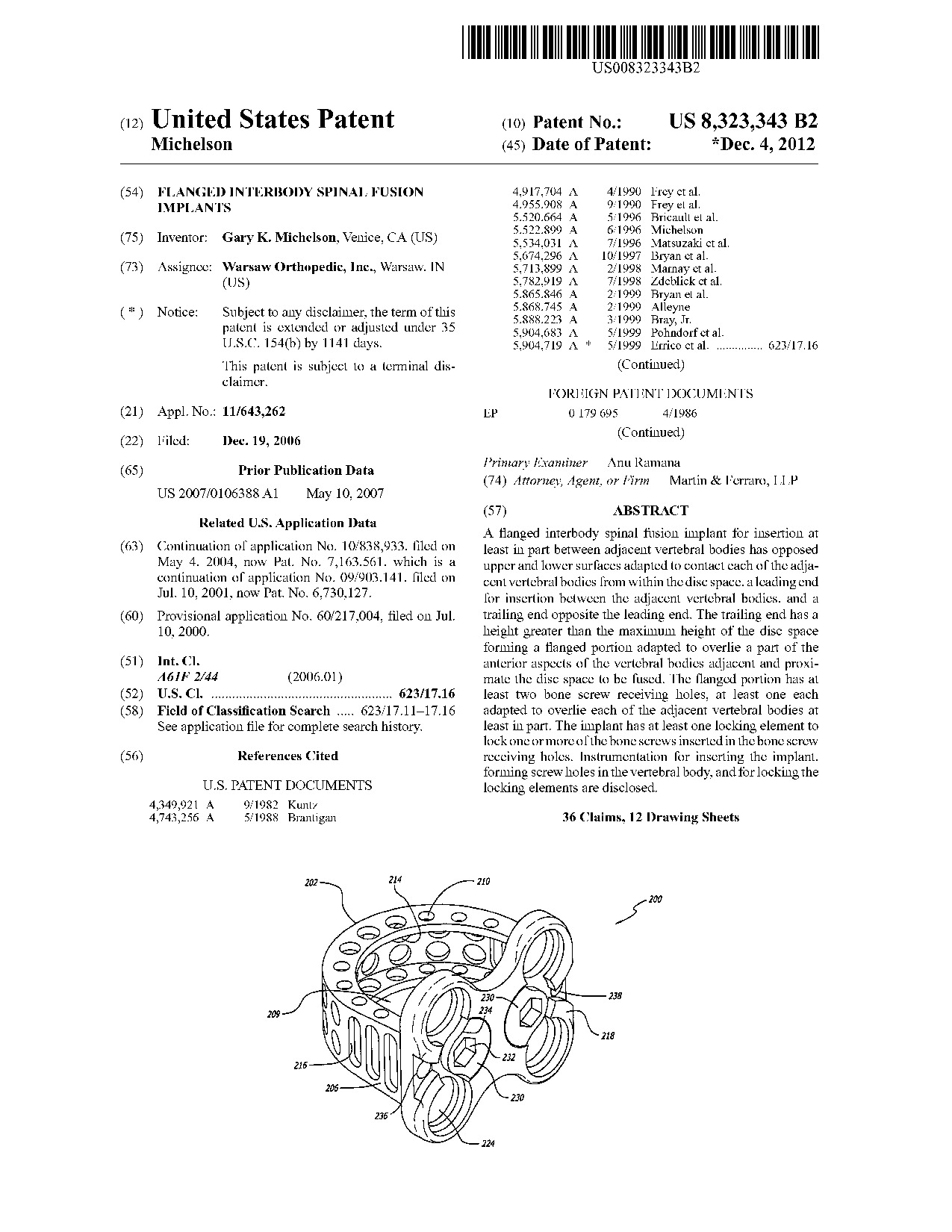 Flanged interbody spinal fusion implants - Patent 8,323,343 Flanged interbody spinal fusion implants - Patent 8,323,343
|
A flanged interbody spinal fusion implant for insertion at least in part between adjacent vertebral bodies has opposed upper and lower surfaces adapted to contact each of the adjacent vertebral bodies from within the disc space, a leading end for insertion between the adjacent vertebral bodies, and a trailing end opposite the leading end. The trailing end has a height greater than the maximum height of the disc space forming a flanged portion adapted to overlie a part of the anterior aspects of the vertebral bodies adjacent and proximate the disc space to be fused. The flanged portion has at least two bone screw receiving holes, at least one each adapted to overlie each of the adjacent vertebral bodies at least in part. The implant has at least one locking element to lock one or more of the bone screws inserted in the bone screw receiving holes. Instrumentation for inserting the implant, forming screw holes in the vertebral body, and for locking the locking elements are disclosed.
|
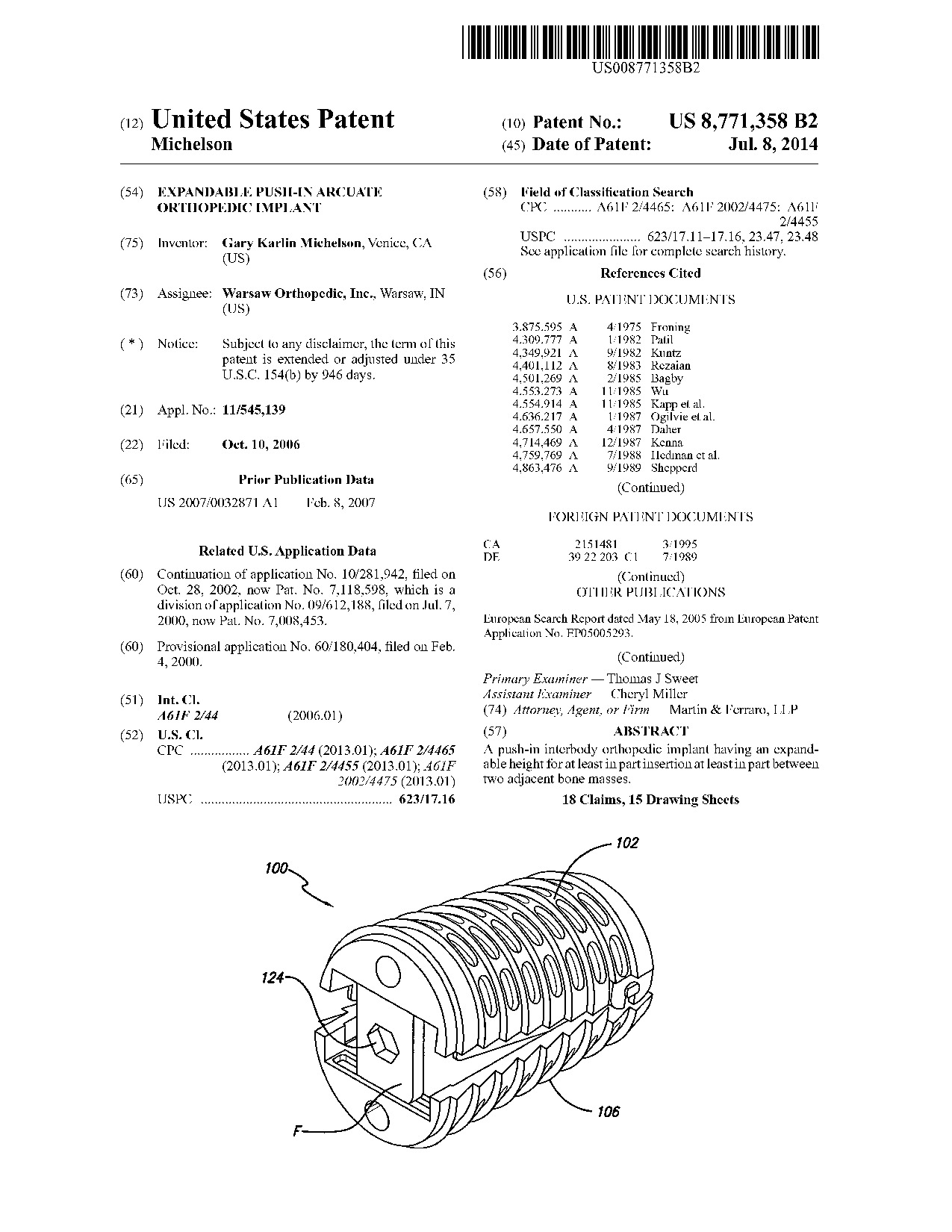 Expandable push-in arcuate orthopedic implant - Patent 8,771,358 Expandable push-in arcuate orthopedic implant - Patent 8,771,358
|
A push-in interbody orthopedic implant having an expandable height for at least in part insertion at least in part between two adjacent bone masses.
|
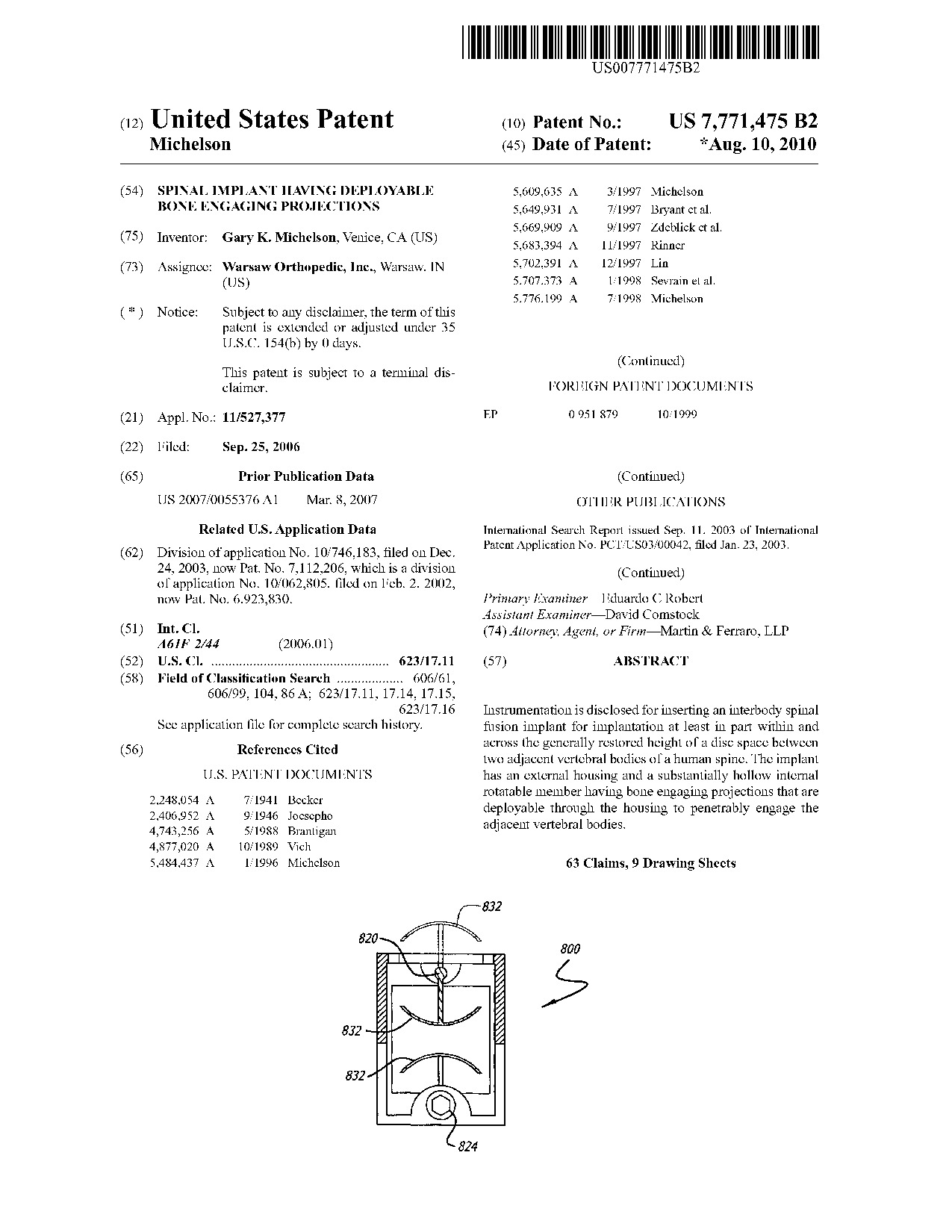 Spinal implant having deployable bone engaging projections - Patent 7,771,475 Spinal implant having deployable bone engaging projections - Patent 7,771,475
|
Instrumentation is disclosed for inserting an interbody spinal fusion implant for implantation at least in part within and across the generally restored height of a disc space between two adjacent vertebral bodies of a human spine. The implant has an external housing and a substantially hollow internal rotatable member having bone engaging projections that are deployable through the housing to penetrably engage the adjacent vertebral bodies.
|
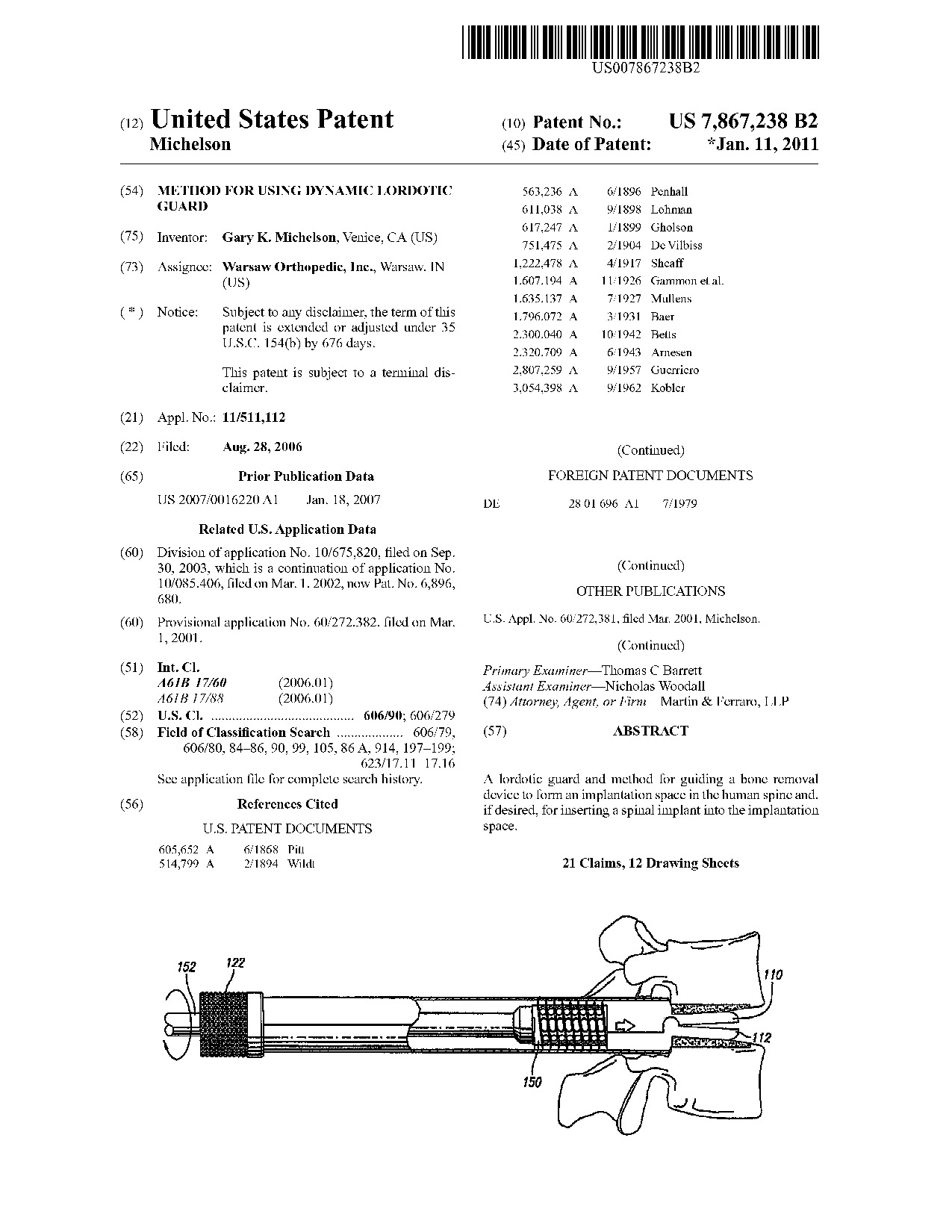 Method for using dynamic lordotic guard - Patent 7,867,238 Method for using dynamic lordotic guard - Patent 7,867,238
|
A lordotic guard and method for guiding a bone removal device to form an implantation space in the human spine and, if desired, for inserting a spinal implant into the implantation space.
|
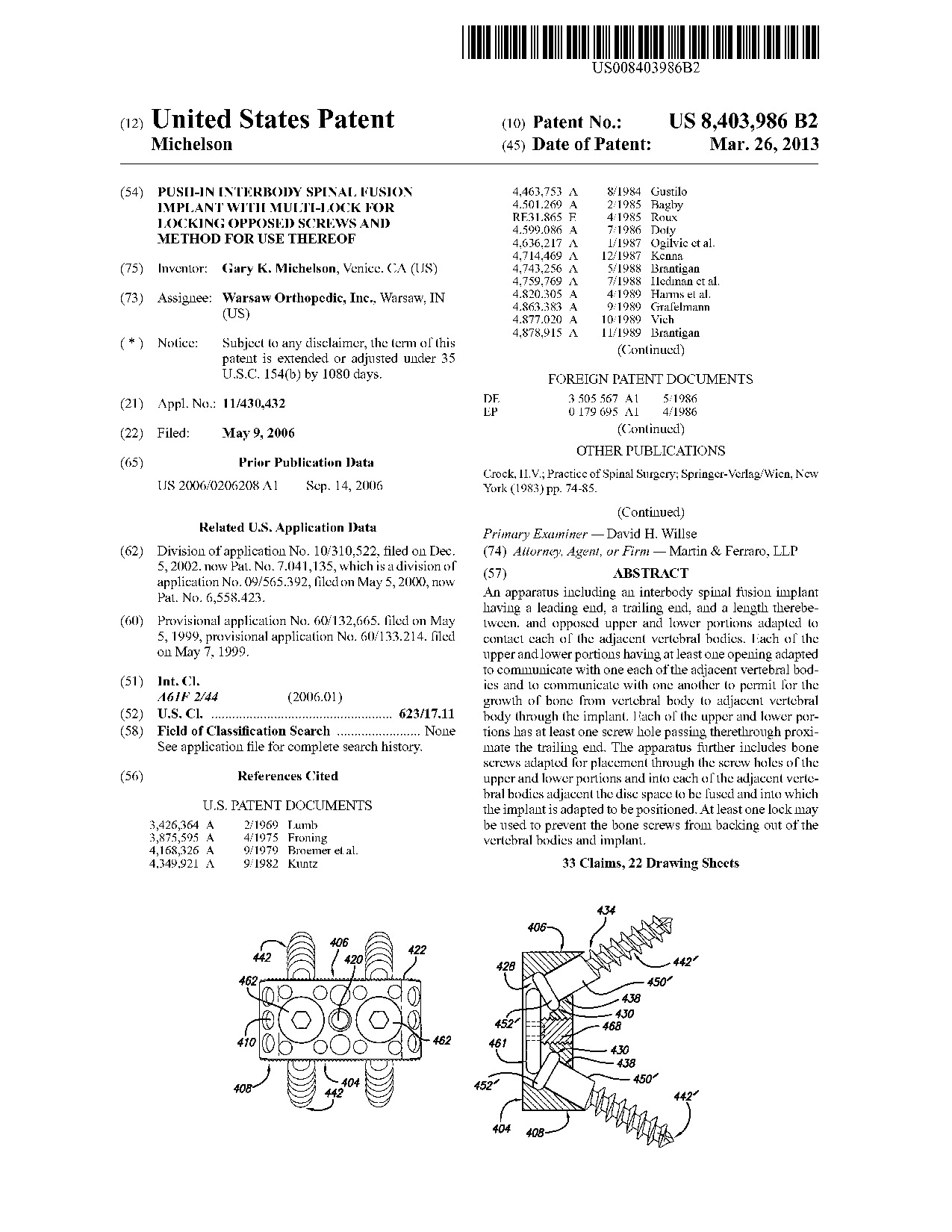 Push-in interbody spinal fusion implant with multi-lock for locking opposed screws and method for use thereof - Patent 8,403,986 Push-in interbody spinal fusion implant with multi-lock for locking opposed screws and method for use thereof - Patent 8,403,986
|
An apparatus including an interbody spinal fusion implant having a leading end, a trailing end, and a length therebetween, and opposed upper and lower portions adapted to contact each of the adjacent vertebral bodies. Each of the upper and lower portions having at least one opening adapted to communicate with one each of the adjacent vertebral bodies and to communicate with one another to permit for the growth of bone from vertebral body to adjacent vertebral body through the implant. Each of the upper and lower portions has at least one screw hole passing therethrough proximate the trailing end. The apparatus further includes bone screws adapted for placement through the screw holes of the upper and lower portions and into each of the adjacent vertebral bodies adjacent the disc space to be fused and into which the implant is adapted to be positioned. At least one lock may be used to prevent the bone screws from backing out of the vertebral bodies and implant.
|
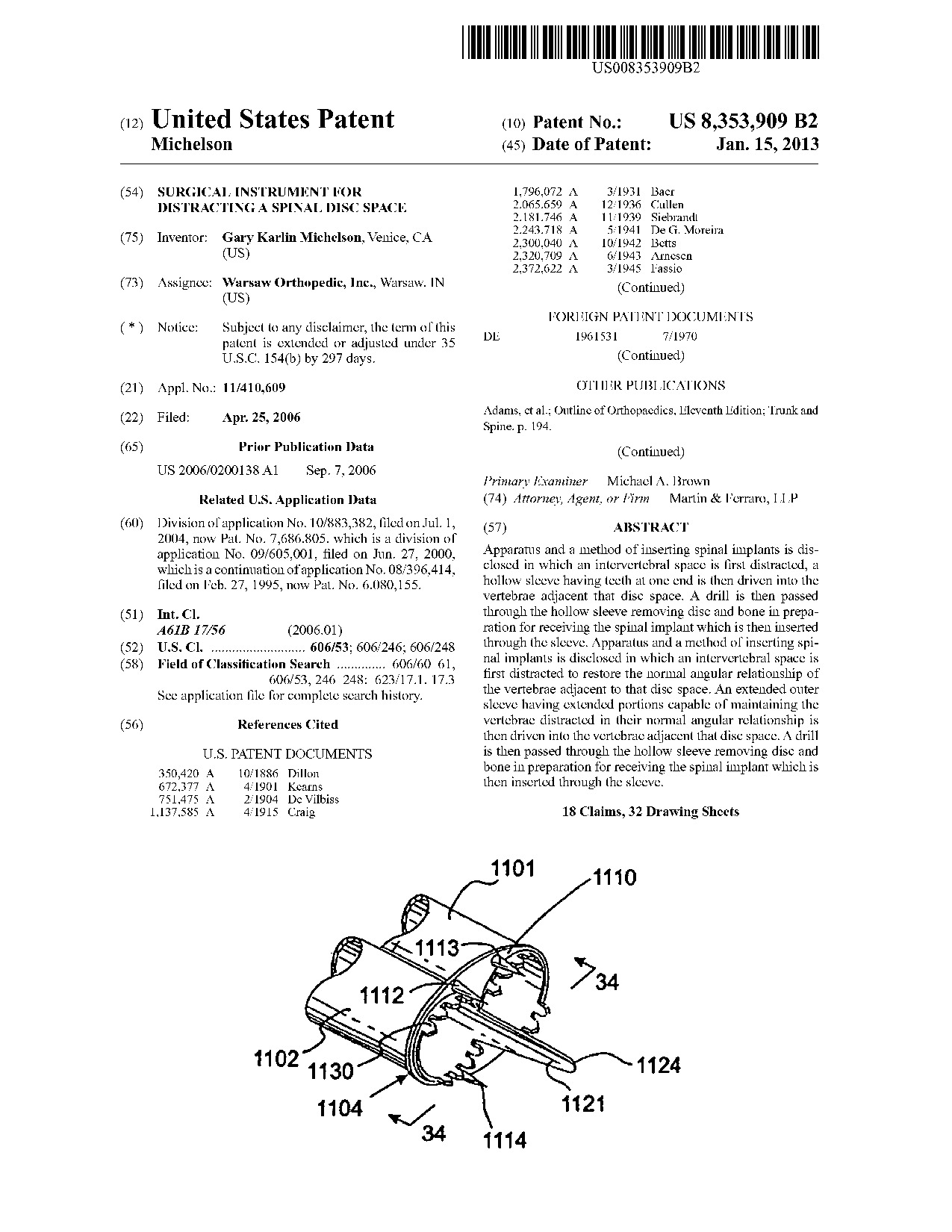 Surgical instrument for distracting a spinal disc space - Patent 8,353,909 Surgical instrument for distracting a spinal disc space - Patent 8,353,909
|
Apparatus and a method of inserting spinal implants is disclosed in which an intervertebral space is first distracted, a hollow sleeve having teeth at one end is then driven into the vertebrae adjacent that disc space. A drill is then passed through the hollow sleeve removing disc and bone in preparation for receiving the spinal implant which is then inserted through the sleeve. Apparatus and a method of inserting spinal implants is disclosed in which an intervertebral space is first distracted to restore the normal angular relationship of the vertebrae adjacent to that disc space. An extended outer sleeve having extended portions capable of maintaining the vertebrae distracted in their normal angular relationship is then driven into the vertebrae adjacent that disc space. A drill is then passed through the hollow sleeve removing disc and bone in preparation for receiving the spinal implant which is then inserted through the sleeve.
|
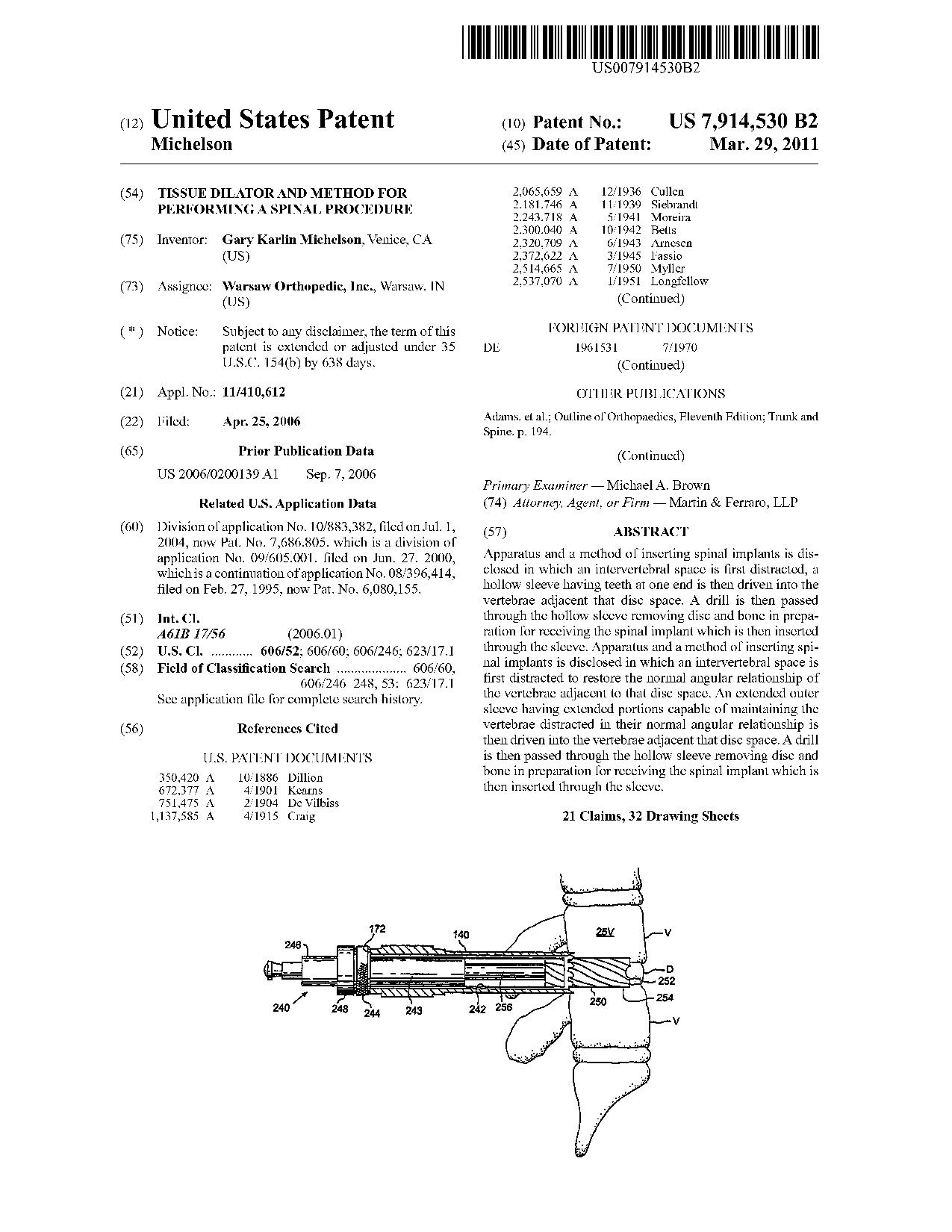 Tissue dilator and method for performing a spinal procedure - Patent 7,914,530 Tissue dilator and method for performing a spinal procedure - Patent 7,914,530
|
Apparatus and a method of inserting spinal implants is disclosed in which an intervertebral space is first distracted, a hollow sleeve having teeth at one end is then driven into the vertebrae adjacent that disc space. A drill is then passed through the hollow sleeve removing disc and bone in preparation for receiving the spinal implant which is then inserted through the sleeve. Apparatus and a method of inserting spinal implants is disclosed in which an intervertebral space is first distracted to restore the normal angular relationship of the vertebrae adjacent to that disc space. An extended outer sleeve having extended portions capable of maintaining the vertebrae distracted in their normal angular relationship is then driven into the vertebrae adjacent that disc space. A drill is then passed through the hollow sleeve removing disc and bone in preparation for receiving the spinal implant which is then inserted through the sleeve.
|
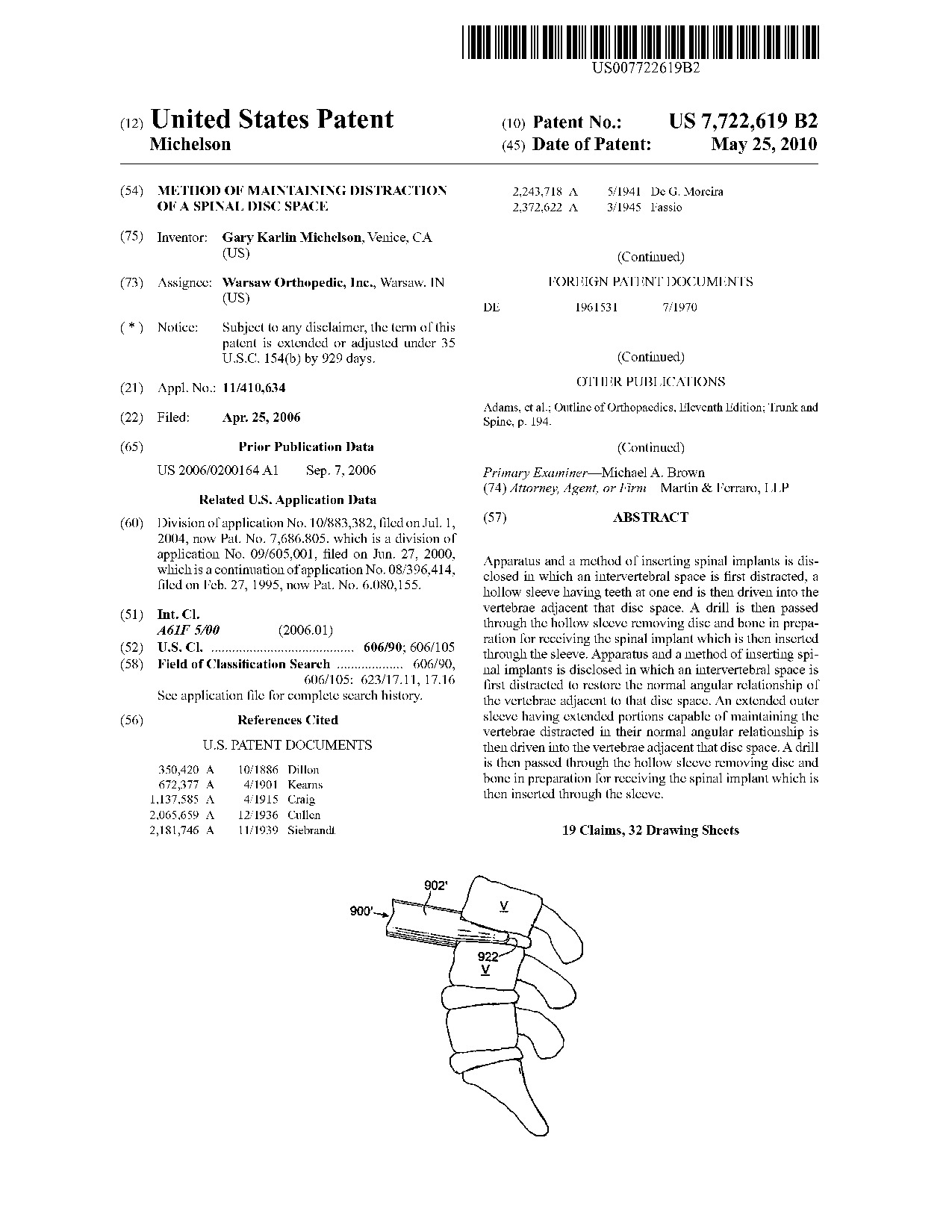 Method of maintaining distraction of a spinal disc space - Patent 7,722,619 Method of maintaining distraction of a spinal disc space - Patent 7,722,619
|
Apparatus and a method of inserting spinal implants is disclosed in which an intervertebral space is first distracted, a hollow sleeve having teeth at one end is then driven into the vertebrae adjacent that disc space. A drill is then passed through the hollow sleeve removing disc and bone in preparation for receiving the spinal implant which is then inserted through the sleeve. Apparatus and a method of inserting spinal implants is disclosed in which an intervertebral space is first distracted to restore the normal angular relationship of the vertebrae adjacent to that disc space. An extended outer sleeve having extended portions capable of maintaining the vertebrae distracted in their normal angular relationship is then driven into the vertebrae adjacent that disc space. A drill is then passed through the hollow sleeve removing disc and bone in preparation for receiving the spinal implant which is then inserted through the sleeve.
|
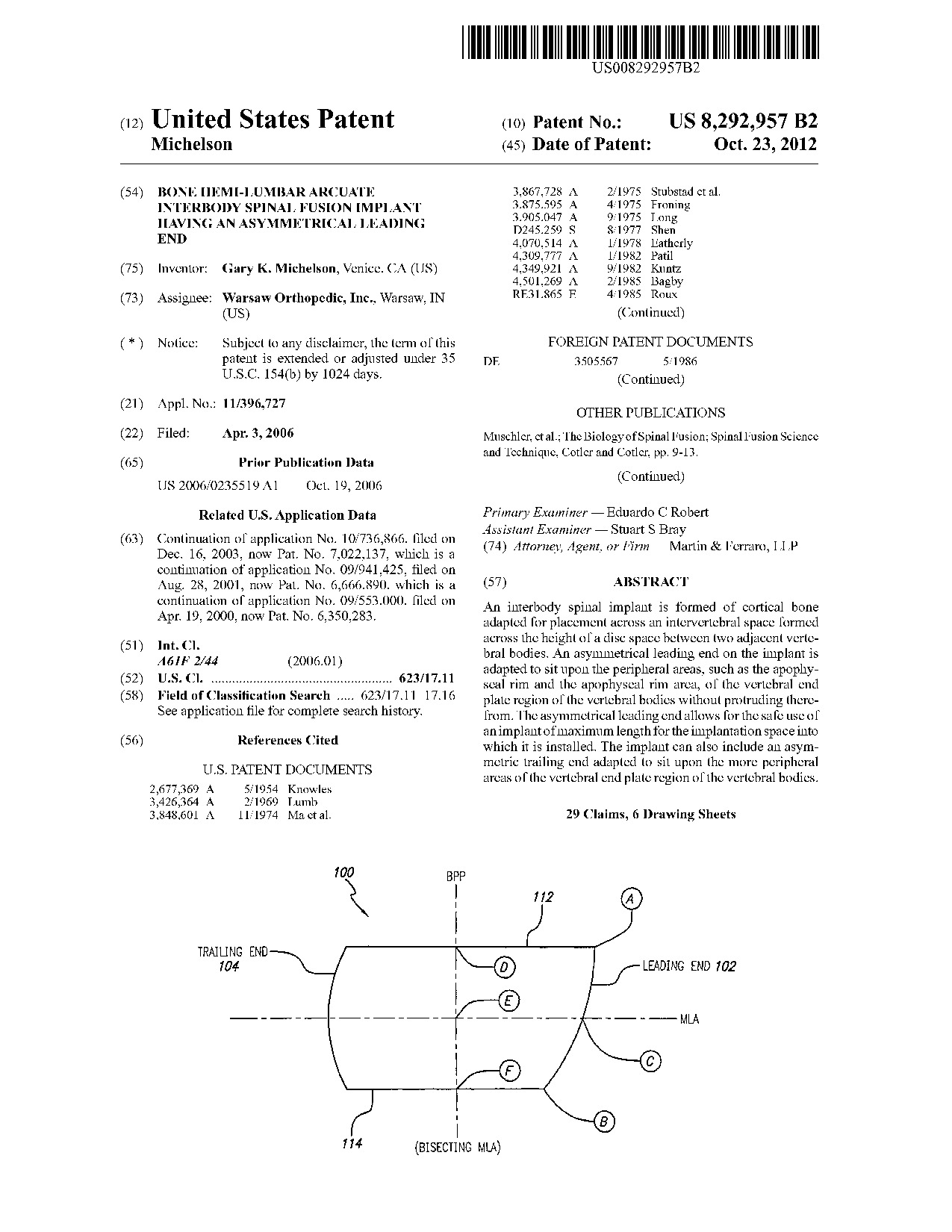 Bone hemi-lumbar arcuate interbody spinal fusion implant having an asymmetrical leading end - Patent 8,292,957 Bone hemi-lumbar arcuate interbody spinal fusion implant having an asymmetrical leading end - Patent 8,292,957
|
An interbody spinal implant is formed of cortical bone adapted for placement across an intervertebral space formed across the height of a disc space between two adjacent vertebral bodies. An asymmetrical leading end on the implant is adapted to sit upon the peripheral areas, such as the apophyseal rim and the apophyseal rim area, of the vertebral end plate region of the vertebral bodies without protruding therefrom. The asymmetrical leading end allows for the safe use of an implant of maximum length for the implantation space into which it is installed. The implant can also include an asymmetric trailing end adapted to sit upon the more peripheral areas of the vertebral end plate region of the vertebral bodies.
|
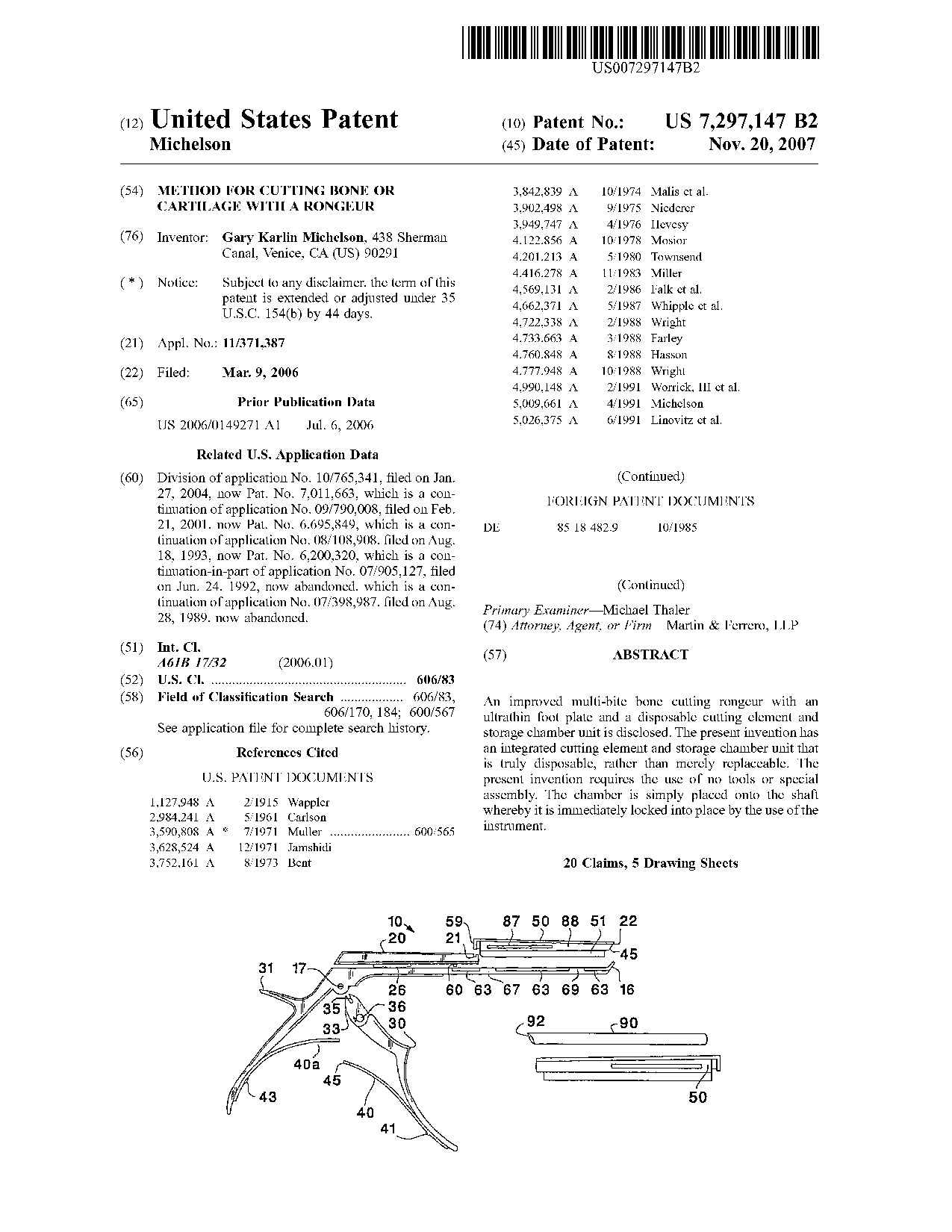 Method for cutting bone or cartilage with a rongeur - Patent 7,297,147 Method for cutting bone or cartilage with a rongeur - Patent 7,297,147
|
An improved multi-bite bone cutting rongeur with an ultrathin foot plate and a disposable cutting element and storage chamber unit is disclosed. The present invention has an integrated cutting element and storage chamber unit that is truly disposable, rather than merely replaceable. The present invention requires the use of no tools or special assembly. The chamber is simply placed onto the shaft whereby it is immediately locked into place by the use of the instrument.
|
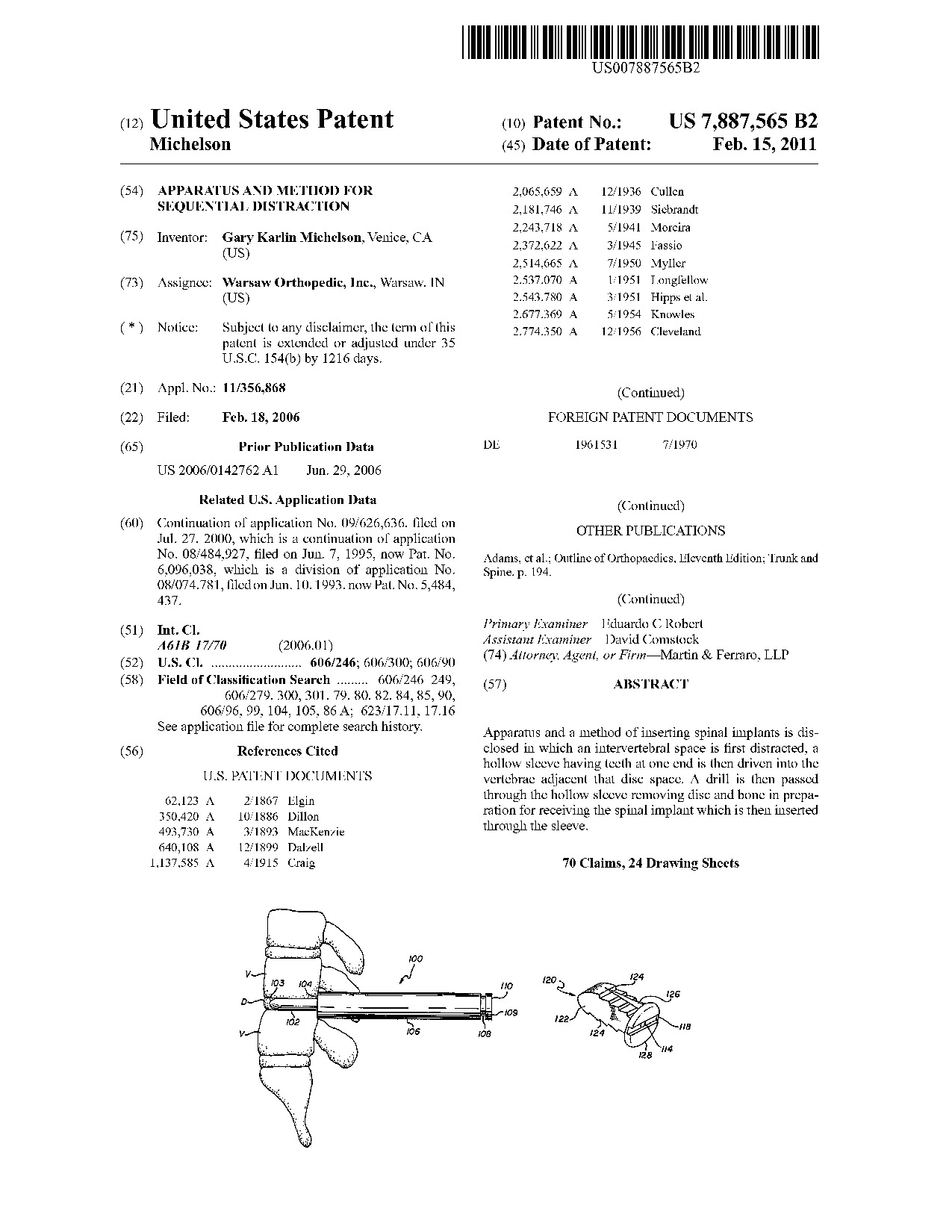 Apparatus and method for sequential distraction - Patent 7,887,565 Apparatus and method for sequential distraction - Patent 7,887,565
|
Apparatus and a method of inserting spinal implants is disclosed in which an intervertebral space is first distracted, a hollow sleeve having teeth at one end is then driven into the vertebrae adjacent that disc space. A drill is then passed through the hollow sleeve removing disc and bone in preparation for receiving the spinal implant which is then inserted through the sleeve.
|
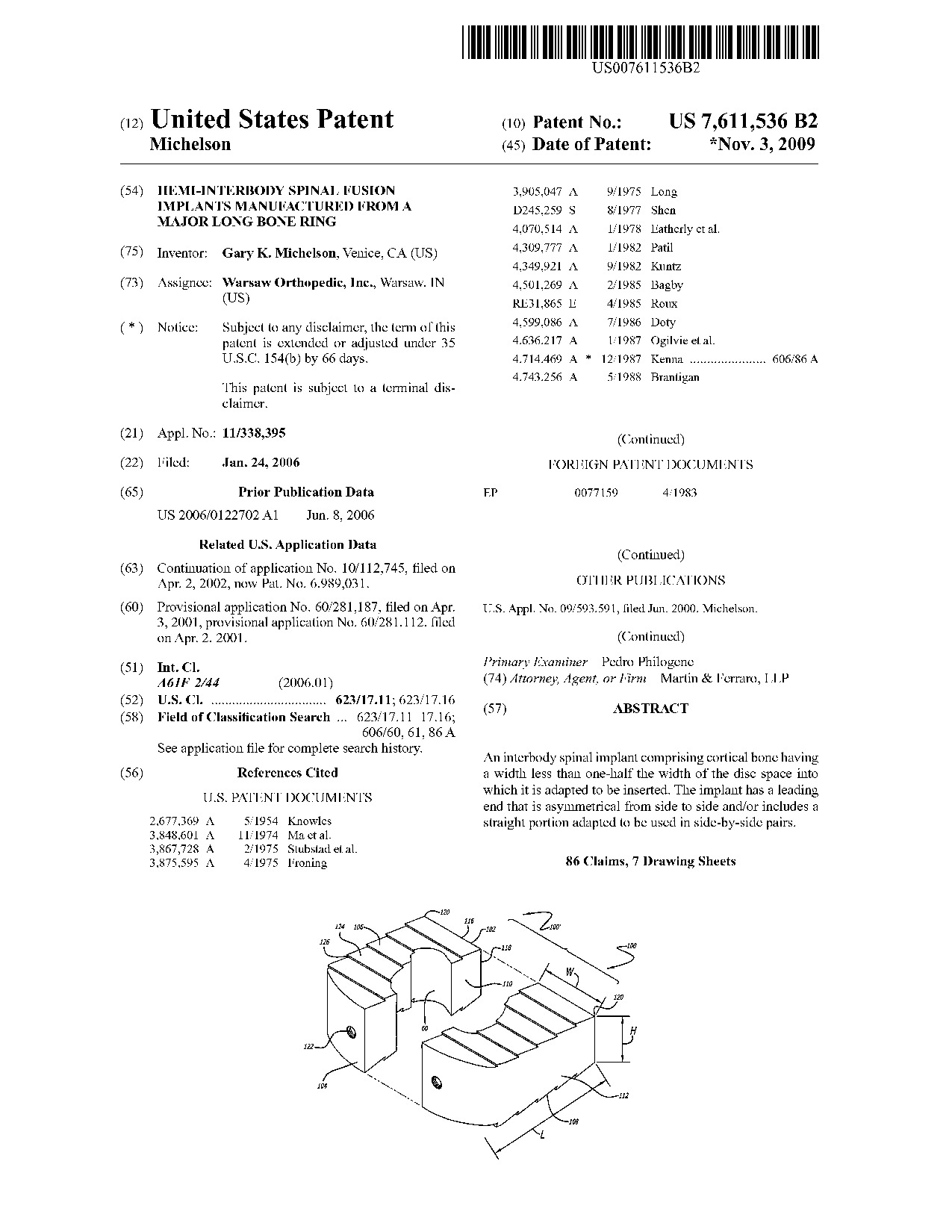 Hemi-interbody spinal fusion implants manufactured from a major long bone ring - Patent 7,611,536 Hemi-interbody spinal fusion implants manufactured from a major long bone ring - Patent 7,611,536
|
An interbody spinal implant comprising cortical bone having a width less than one-half the width of the disc space into which it is adapted to be inserted. The implant has a leading end that is asymmetrical from side to side and/or includes a straight portion adapted to be used in side-by-side pairs.
|
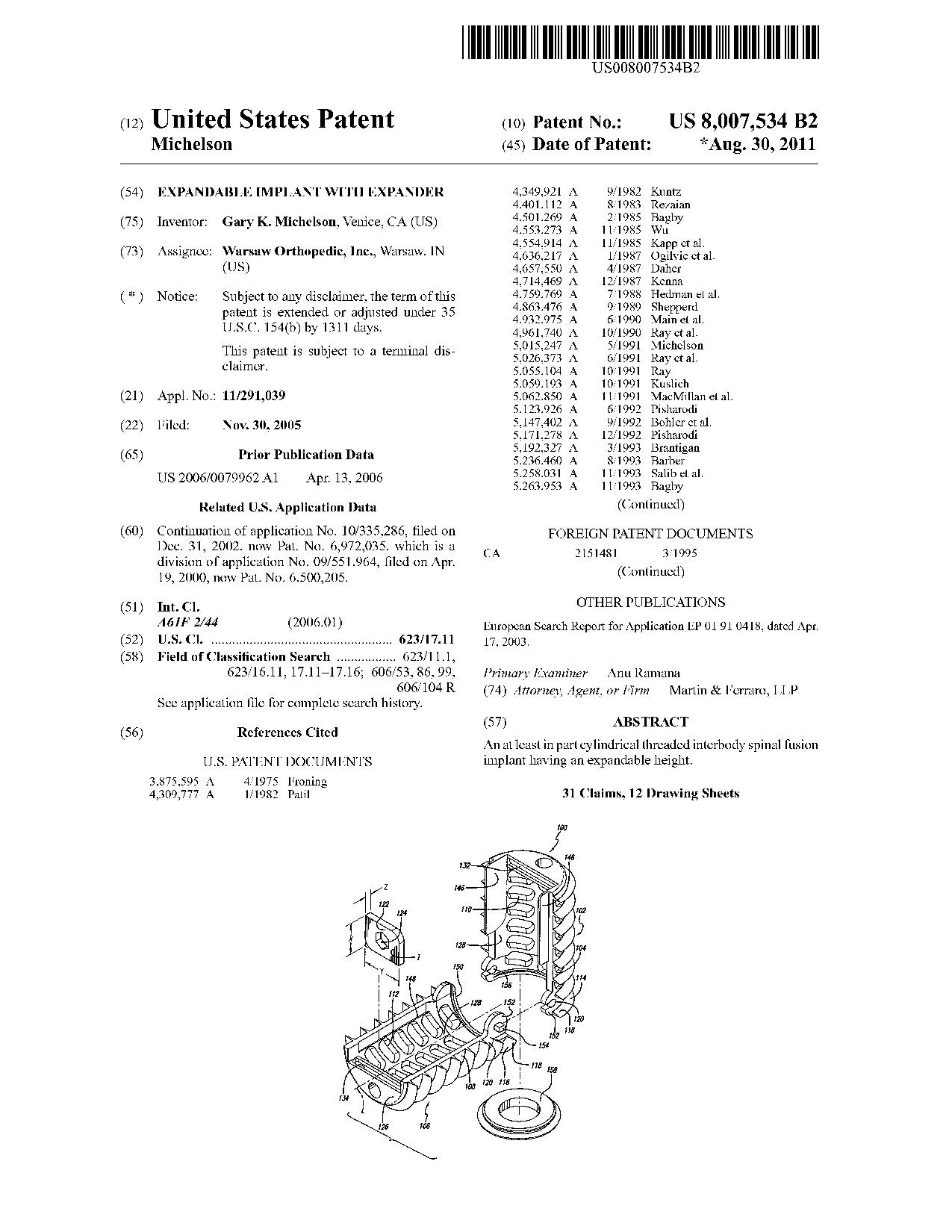 Expandable implant with expander - Patent 8,007,534 Expandable implant with expander - Patent 8,007,534
|
An at least in part cylindrical threaded interbody spinal fusion implant having an expandable height.
|
